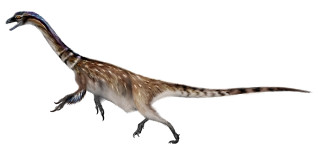Falcarius utahensis

Name: Falcarius utahensis
(Pronunciation: fal-CARE-ee-us YOU-tah-EN-siss)
Age: Early Cretaceous (~125 million years ago)
Where It's Found in Utah: southeast of Green River in Grand County, Utah.
Geologic Formation: Cedar Mountain Formation (Yellow Cat Member)
Classification: Saurischia - Theropoda – Coelurosauria - Therizinosauroidea
Description: Falcarius means “sickle-cutter.” This dinosaur is named for its sharp, curved claws that reached 4-5 inches (10-13 centimeters) in length. However, this fearsome looking creature was a plant eater with leaf-shaped teeth, a long neck, and relatively long arms and tail. It stood about 4.5 feet (1.4 meters) tall, was nearly 13 feet (4 meters) long from head to tail, and walked on two legs. Paleontologists think it probably had a covering of downy feathers based on exquisite fossils of relatives from China.
Why It’s a Top NMHU Dinosaur: Falcarius utahensis belongs to a group of dinosaurs called theropods, which includes all carnivorous dinosaurs. But this species evolved into a plant eater! It is one of the earliest examples of a theropod that eats plants. In fact, it may be one of the only dinosaurs to have been caught in an evolutionary diet shift. Falcarius and its plant-eating relatives are called therizinosaurs. Later theriznosaurs had much longer claws and large potbellies. Some paleontologists have likened these big, slow herbivores to the giant ground sloths that once roamed the Americas. Nearly all therizinosaur fossils have been found in Asia, so the discovery of Falcarius (and Nothronychus graffami, another therizinosaur) in Utah was quite a surprise. The bones of Falcarius were excavated at a site containing hundreds or maybe even thousands of individuals representing one of the largest known death assemblages of theropod dinosaurs.
Where Can I See It?: The Past Worlds Gallery at the Natural History Museum of Utah.
Suggested Reading/References:
Kirkland, J. I., L. E. Zanno, S. D. Sampson, J. M. Clark, and D. D. DeBlieux. 2005. A primitive therizinosauroid dinosaur from the Early Cretaceous of Utah. Nature 435:84-87.
Zanno, L. E. 2010. Osteology of Falcarius utahensis (Dinosauria: Theropoda): characterizing the anatomy of basal therizinosaurs. Zoological Journal of the Linnean Society 158:196-230.
Utah Geological Survey. Killer Dinos Turned Vegetarian.
Credits:
Image: © Victor Leshyk
Author: Deanna Brandau, Paleontology Graduate Student at the Natural History Museum of Utah (2012)